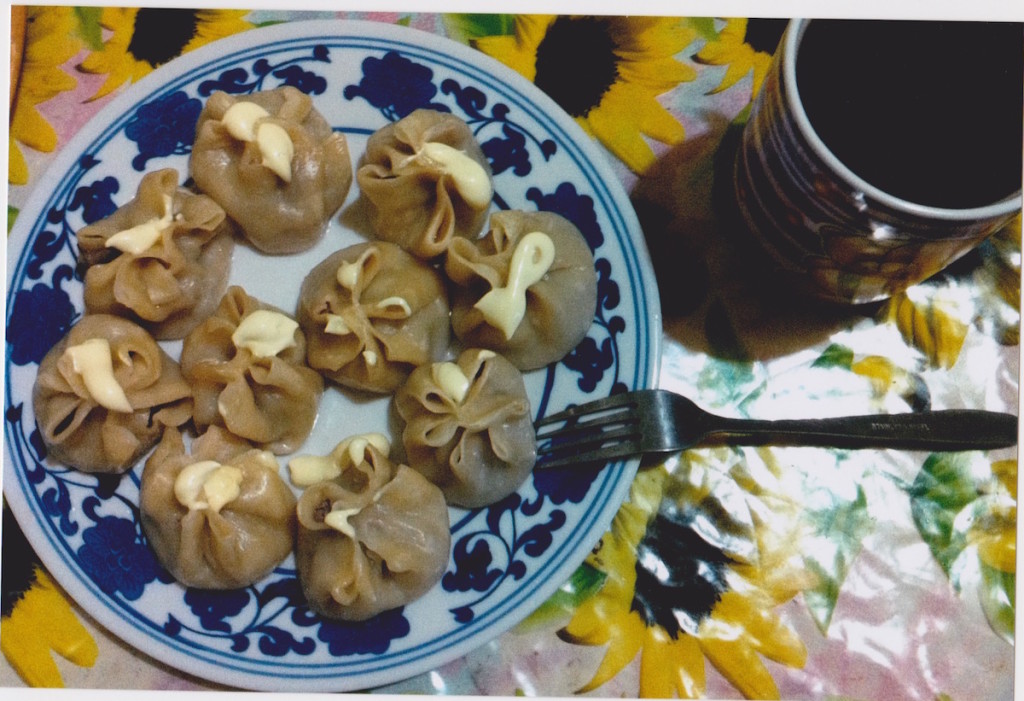
Mongolian buuz with coffee, from my host mother in Ulaanbaatar. Photo: Natasa Bansagi.
It all started with the travel bug. I spent my first year of undergrad in England and was itching to go back overseas. I was confident I’d find my way back there somehow, but I had no idea that doing so would take me to a place I couldn’t even identify on the map: Mongolia. Or that it would take me about 20 hours on the plane to get there.
I landed in May of 2013 to begin a three-month journalism internship at a TV station in the capital city, Ulaanbaatar. A few things stood out right away: the crazy traffic, the unique cultural traditions, such as not placing your bag on the ground, and the food. I quickly learned that I’d be surviving on a meat- and starch-heavy diet. Potatoes, carrots and onions would replace any notion I had of vegetables as green crunchy things.
I settled on a shredded carrot salad at the supermarket cafeteria near my work, to get my raw vegetable intake. It was loaded with creamy dressing—but it was a vegetable.
As I learned, the starchy Mongolian diet comes from the country’s nomadic history that still forms a huge part of the culture. There are few “cities” in this country. Much of it is vast open land, sparsely filled with nomadic people who live with their herds and families in round tents they call gers.
As the families pack up all their belongings and move to a new spot on the land at various points during the year, there isn’t really time to grow and tend a stationary garden. And, to boot, only a small percentage of the agricultural land in Mongolia is arable.
When my host mother made me a dish called “buuz” for the first time, it was so delightful that I couldn’t contain my taste buds. It was so new that even my phone couldn’t recognize the term when I tried typing it (it auto-corrected to “booze”). Buuz is the Mongolian equivalent of a dumpling, and is generally served with mutton inside, another popular ingredient here. There are two ways the dough is prepared—one, a chewy version and the other, more bread-like. Buuz and khuushuur, which is a thin piece of mutton with fried dough on the outside, are both very traditional Mongolian dishes.
At the end of June I visited a family in the countryside, to film a documentary about nomadic life. This was one of the most difficult and rewarding experiences I’ve ever had in journalism. What made it challenging was the fact that while I spoke very little Mongolian, I was striving to connect with the family in order to tell their story. I quickly learned the value of immersing myself in a culture to get the best sense of what life was like for this family. That meant assisting with daily tasks and eating the food, no matter how different it was from the type of dinner I was used to eating in Canada.
While the family carefully prepared the organs of a freshly slaughtered sheep one day, on another occasion, the mother, Ichinnorov, prepared buuz, once she found out how much I liked this dish. I’ll never forget the way she expertly folded the dough to leave a small opening at the top of the dumpling, her hands used to a motion that she’d undoubtedly repeated hundreds of times. We shared some laughter as I attempted to imitate her, unable to work at Ichinnorov’s speed. I learned about the different ways of folding the dough, one of which looked like a rose.
Three years later, I can still almost taste the chewy dough that makes buuz so delicious. But even more memorable is the fact that food was a window on a culture that was once as foreign to me as my phone was to the word buuz.
Tags: buuz, Mongolia, Ulaanbaatar
Your Comments